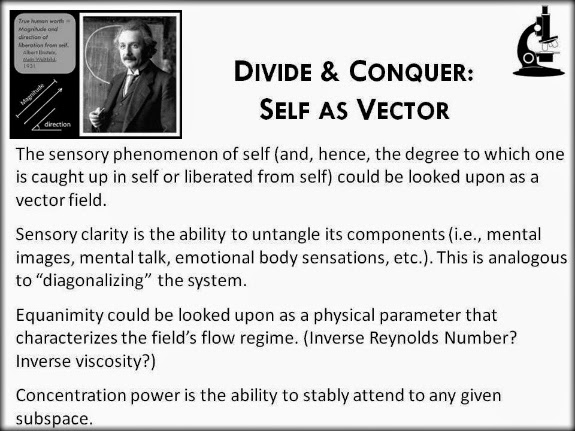“If there is no self in All Rest…then who is seeing and noting?”
I give a standard power point presentation that outlines my hope for how science and mindfulness could cross-fertilize with each other to the dramatic benefit of humanity. In that presentation, I mention an interesting quote by Albert Einstein. Here are the relevant slides.
So Einstein said: “True human worth equals the magnitude and direction of liberation from self.” What’s revealing about this quote is that Einstein, having been trained in mathematics, is thinking of the endeavor of transcending self as a vector-valued function rather than a scalar-valued function. Translated into ordinary English, that means that in fact “No Self” is a multi-dimensional phenomenon. Put another way, there are various sizes and flavors of experience that might be described as No Self.
One flavor of No Self would be a spontaneous deactivation of inner See-Hear-Feel activity (See Chapter 1 of my manual).
Another flavor of No Self comes about when the mind-body elements get disentangled (See The Five Khandhas paradigm of early Buddhism).
Yet another flavor of No Self comes about when we dis-identify with the Content of mind and body and re-identify with the Flow (See Chapter 4 of my manual) and Contour of mind and body.
Yet another flavor of No Self comes about when we can detect the continuous goneness of every experience and, furthermore, identify with the Goneness and disidentify with the mind and body.
As to the central point in your question, which, if I paraphrase, boils down to
“If there is no self, who is meditating?”
For more details see the following videos (with thanks to Har-Prakash Khalsa):
- Self-Enquiry & Mindfulness Meditation
- The Absolute Witness
- From Surface to Source & the Gold Standard for Spiritual Maturity




This is an amazing synchronicity for me. Not 2 hours ago I wrote this in my journal: Emotion is thought associated with sensation. Emotion can be dis-integrated by eliminating one of its components.
ReplyDeleteIf we can equate annica (impermanence) with emotion (e-motion = of motion = change) then Einstein's equation says exactly that: emotion = thought + sensation. His mathematical construct using partial derivatives can be viewed loosely as activity, eg, dI/dt can be thought of as the rate of change of visual thought, dT/dt the rate of change of talking thought and dF/dt the rate of change of physical sensation, or somesthesia (I would have used S instead of F).
But he got the equation wrong: It should be:
emotion = thought x sensation
or
emotion = dTHOUGHT/dt x dSENSATION/dt
or
emotion = (dI/dt +dT/dt)(dF/dt)
Proof: if you set both the partial derivative components of thinking to zero,or set the partial derivative representing sensation to zero, the result will be zero emotion because multiplying anything by zero equals zero.
This agrees with our experience thus:
The essence of most meditation techniques is to quite the mind, ie, set (dI/dt + dT/dt) = 0. One way to do that is to focus exclusively on the sensation component of an emotion, letting thought die out.
Another way is to focus exclusively on the thought component of an emotion and the sensation dies away. In either case, one component of the product equals zero so emotion equals zero.
Taking this a step further we can say that the sense of a separate self is nothing more than the aggregate of emotions that we are willing to defend (the ego process that creates homeostasis in everything from sub atomic particles to molecules to organs to organisms to, unfortunately, belief systems). Hence we can apply Einstein's equation to explain liberation.
Just thought to point out what I think Shinzen meant there - I don't think he was claiming that Einstein proposed partial differentials in the form of human experience. He was pointing to a quote from Einstein, which he takes to be equivalent to "True human worth = magnitude + direction of liberation away from self". I believe those slides are of Shinzen's making, not einstein's. (Not that any of what I've said is a comment for or against what you have written above.) Regards,
DeleteThanks for this, Shinzen!
ReplyDeleteI find your mathematical analogies interesting and helpful (at least when they are concepts that I'm familiar with). It's also interesting that you manage to use mathematical concepts to describe consciousness and it's meditative transformations by analogy in a useful way. This is in stark contrast to the way in which math is used by some spiritual teachers. Usually, if a spiritual teacher starts using math to transmit spiritual understandings, it is a sure sign of fraud. Numerology, simplistic geometric charts, etc are all bad signs, in my view. But you manage to make these work.
Wow this post's incredible!
ReplyDeletewhat you are describing (no self) is a merely a subjective experience...a subjective phenomenon...
ReplyDelete"The quick answer is “the habit of meditating is meditating,” just like the habit of driving the car can drive the car even when you have no conscious perception of a driver."
Doesn't this place you back where you started in that having no conscious perception, does not relieve you of selfhood, surely ? At best you are relegating and comparing 'no self' to a mere automatic function...that of unconsciously piloting a car...a bit like a habit that you are no longer conscious of..?
Non self is not accessible or describable in language. It is an experience beyond linguistic description.
Part of the problem here is that the Buddha hinted at something called "the Unborn" but failed to explicate it and left us hanging and did not elaborate on it. It seems that his experience of the Unborn was likely inexplicable, so he left things as they were. I wonder if we should also do the same, rather than bastardising Einstein's work for quick and easy answers